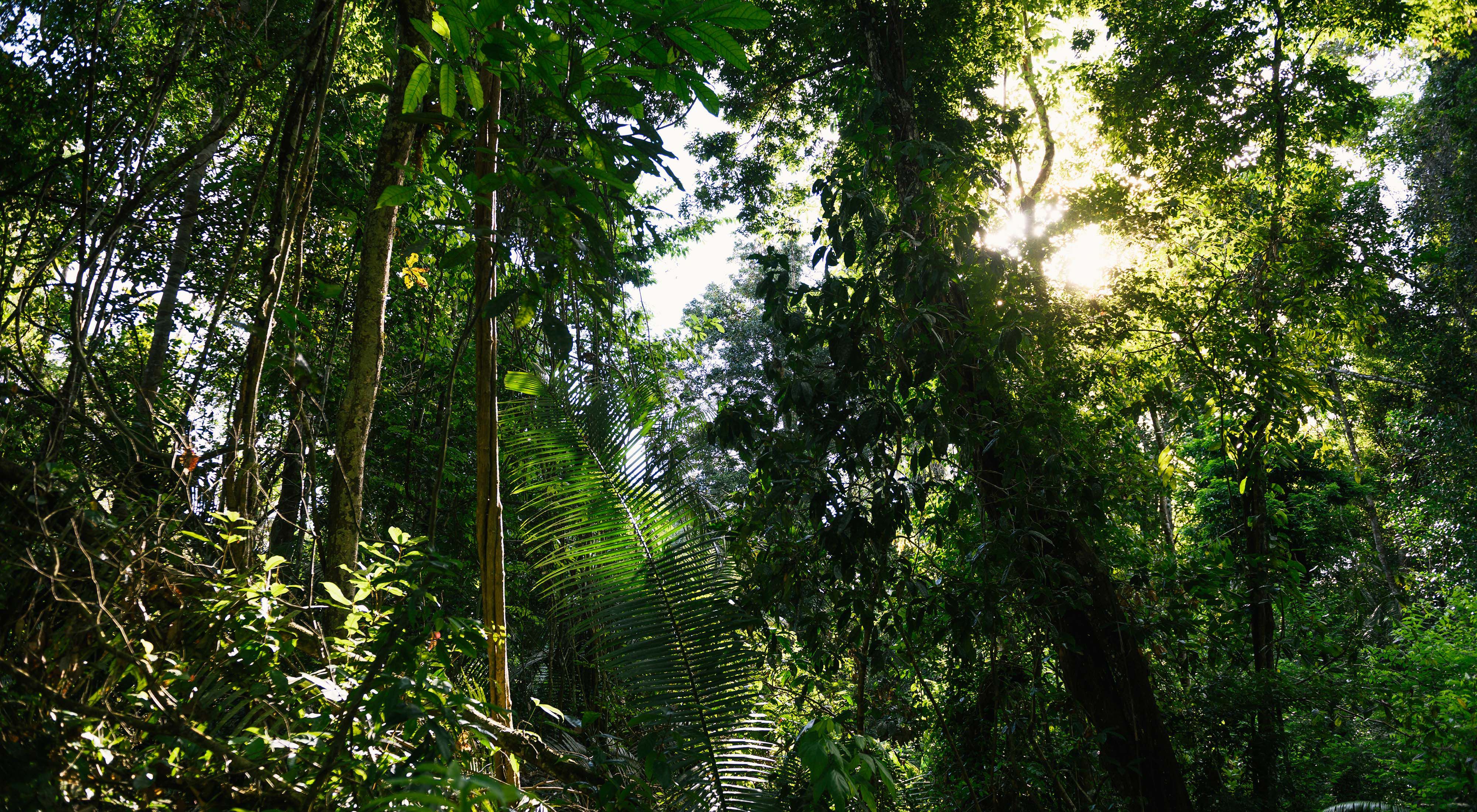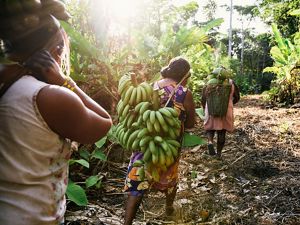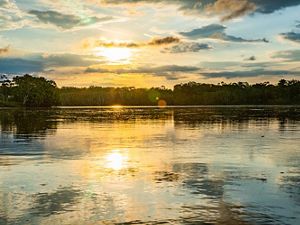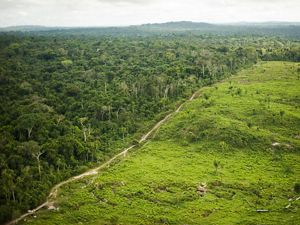Reforesting the Amazon
After decades of turning forests into pastures and fields, Brazilian landowners have begun reversing the trend.
April/May 2016
Lazir Soares de Castro stands amid white and gray Nelore cattle on his ranch in São Félix do Xingu, a remote and sprawling county on Brazil’s northeastern Amazon frontier. Beyond a wooden fence, high grass and scrub brush fade into sporadic trees in the distance.
Still vital at 70, Soares describes how different this area looked when he arrived in 1984, when it was all virgin rainforest. “It was the poorest area. There was no electricity, no telephone, no TV, no roads, nothing.” The military dictatorship then running the country was encouraging settlers to occupy the Amazon in the name of national security. “There was no organized environmental policy,” Soares says.
The results were sadly predictable. Deforestation spread rapidly across Brazil’s portion of the Amazon, an area more than two-thirds the size of the conterminous United States. By the time The Nature Conservancy started working in São Félix in 2009, says Ian Thompson, director of conservation for the organization’s Brazil program, the situation was so bad that the county had been added to a new environmental blacklist generated by the federal government. The county, nearly the size of Portugal, saw almost 300 square miles of its forests felled in 2008, the highest rate of municipal deforestation in the entire Amazon. “São Félix do Xingu was the symbol of a frontier out of control,” Thompson says.
Now, thanks to efforts by the Brazilian government, the Conservancy and other partners, the situation has started to shift. New tools are encouraging ranchers and farmers—who often don’t even have title to the land they homesteaded—to improve and restore the health of their holdings. A new land registry project shows where the most work needs to be done. And efforts are under way to develop a productive local economy that will keep forests intact while allowing residents to make a living.
“If São Félix can make this real for all of its communities, it will surely provide lessons for all of the Amazon,” Thompson says. But in the end, he says, success will hinge on ranchers like Soares.

Throughout Brazil's history, the Amazon Basin has been the country’s equivalent of the old American West: vast, largely lawless and sparsely populated by indigenous groups. A century and a half after land grabs and Manifest Destiny pushed Americans toward the Pacific Ocean, a similar process occurred in Brazil. Government policies in the 1960s and 1970s encouraged settlers into the region, offering free land and economic assistance to impoverished families from crowded coastal regions in this “land without men for men without land.”
Airports appeared and roads sliced through the forest to tie the far-flung states to population centers in the east and south. The trans-Amazonian highway project, started in 1972 and still unfinished, currently stretches approximately 3,000 miles from east to west.
Soares was part of a wave of migration in the 1980s. An explosion in the soybean market spurred a second large migration in the 1990s and 2000s, when large agricultural firms snapped up farms and cattle ranches in other Brazilian states to plant soybeans, which can be harvested twice a year in the tropics. This pushed more settlers even farther into the forest.
The highly disorganized process birthed corruption and violence and left many settlers with land titles that were unclear or nonexistent. It also served as a recipe for deforestation. Just as settlers in the American West had to “improve” their holdings to receive government support—clearing the land, erecting buildings, and planting crops or grazing cattle—immigrants to the Amazon were essentially required to raze the forest as they went.
Luiz Martins Reis Neto, the owner of a small ranch in São Félix, says that in 1988 he came cortando, literally chopping his way through the trees. “We would cut down and set fire to the forest to create space to plant crops to feed the cattle,” he says. “Everyone would get together and torch the forest.” The settlers didn’t know any better, he said, and were given little or no guidance by the government about how to use the land efficiently. This started a vicious cycle rooted in the ecology of the rainforest. Nutrients do not run very deep in the area’s clay-rich soils, so after a few years of grazing or planting, the ground turns hard and unproductive. Farmers and ranchers were forced to clear more and more land for new fields and pastures.
From 2001 to 2012, Brazil was responsible, on average, for three-quarters of the deforestation in the Amazon Basin, primarily through ranching and large-scale agriculture. At deforestation’s peak in 2004, about 10,700 square miles of the country’s Amazon forest were cut down. The problem was especially acute in the state of Pará, where São Félix is located, in large part because it is home to the largest cattle herd in the country, at more than 2 million head.

About 80 percent of the Amazon forest still stands today, but in the 1990s and 2000s the rate at which it was falling caught the world’s attention. As national and international pressure followed a growing public awareness of deforestation and its effects on global climate change, Brazilian government policy began to shift away from promoting settlement and toward encouraging sustainable development. The creation of the blacklist in 2008 was a clear sign. Inclusion on the list resulted in stricter federal oversight and economic sanctions against counties to discourage deforestation.
Market forces were also coming to bear, as consumers demanded that products from the rainforest be sustainable. In April 2009, the Conservancy was invited to São Félix by a meat-packing company that was having problems finding suppliers in compliance with the country’s forest code. First passed in 1965, the code required (among other things) that Amazon landowners set aside 50 to 80 percent of their land as protected rainforest or regrowth, or else buy more property as an offset.
Until 2009 the requirement had been widely ignored, says Marcio Sztutman, critical lands manager for the Conservancy in Brazil. Tensions were high when the Conservancy first showed up in São Félix, he says. Producers like Soares and Reis Neto were furious at the federal and state governments for creating the situation—and for making them bear the brunt of the blame. “They don’t like to be seen as criminals,” Sztutman says. “They much prefer to comply with regulations, if it allows them to maintain their livelihood.”
Heads cooled once Conservancy staffers explained that they were there to help, not cripple, the local economy. Over the next year, the Conservancy helped São Félix and other counties set up a computerized rural land registry known by its Portuguese acronym, CAR. Landowners were required to help map and register their properties and assume responsibility for taking care of the land.
Registration was essential for compliance with the forest code because it solved a critical problem, Thompson says. Even though Brazil has some of the best satellite land data covering the Amazon, if the government didn’t know who owned what, it was nearly impossible to assign responsibility. “We had all this great deforestation data, but nobody knew whose property it was on,” he says. With the registry, “if you can monitor it from space, you can tell who is in compliance or not.”
The situation has been complicated because of the unclear state of land tenure in the region. Less than 4 percent of private land in Brazil’s Amazon has clear ownership records today. That’s why the Conservancy pushed to decouple the registration process from establishing ownership, though registration is also a step in that direction, Thompson says. Although registering property doesn’t confer legal tenure, “at least people are in-system and know they can be tracked,” he says. “It’s a sign that they’re willing.”
The process got a boost when changes were made to the forest code in 2012. Some changes made conservation more difficult and complicated, says Sztutman, but the revision also made land registration required by federal law, with all rural properties to be registered by May 2016. This created an incentive for landowners to comply with the code, Sztutman says.

Reducing deforestation was just one side of the equation. The other was helping landowners make their already cleared land more productive. By intensifying production through better husbandry practices such as rotational grazing, ranchers could keep more cattle per acre. Soares, one of more than 20 producers in a local sustainable beef association, saw his cattle density nearly triple in just two years.
Reis Neto divided his land into smaller pastures, some of which he rents to other ranchers for grazing. In so doing, he says he can earn twice as much in the same area, without cutting down any trees. “When I joined the project, some people warned me: ‘Be careful, nobody gives anything to anyone.’ Then they started to see the results, and now they ask me to introduce them to the conservation folks.”
IBM also collaborated with the Conservancy to develop and improve a software tool to track deforestation, mating the counties’ massive land database with software that compares farm plots with historical satellite images. This way authorities can track compliance with the forest code over time, as well as formulate effective land-management plans. Depending on the location, as much as 80 percent of the land must be left intact. Once they are in the system, operators who have cleared beyond their limit must register which areas will be left to regrow.
Some farmers are helping the process along by replanting native species such as cacao, banana and hardwoods, which can provide a reliable source of income. The Conservancy is helping small farms in São Félix increase food production without causing habitat loss. As an added benefit, these agroforests of native species count as replanted forests for compliance with the law.
At the state level, the Conservancy has worked to implement CAR in 12 counties in Pará and neighboring Mato Grosso, a state with comparable levels of deforestation. As of November last year, 166,455 properties in Pará were registered, covering nearly 150,000 square miles, or two-thirds of the state. About 7,500 São Félix properties were among that number. One of the main challenges now, says Thompson, is to scale up the registration process to hundreds of counties and eventually more than 5,000 across the country. Another challenge is linking the three levels of CAR—county, state and federal—and making them compatible with one another.
Meanwhile, deforestation in Brazil’s Amazon has been slowly but steadily decreasing since 2004. In 2014, less than 60 square miles of forest was cleared in São Félix. This wasn’t enough to get it off the blacklist, but in 2010 the Conservancy helped the nearby county of Paragominas become the first to drop off the list after it reduced deforestation and achieved 80 percent land registration. “People are starting to believe that rural registration is really working,” says Benito Guerrero, a Conservancy land use specialist in Brazil. “Paragominas is a model demonstrating that it’s possible for economic development and environmental protection to work hand in hand.”

To ensure that rainforest products are produced sustainably, the Conservancy has been working with private companies to set up deforestation commitments in their supply chains. Companies such as Cargill have already pledged to set up tracking and to stop using any soy whose production causes deforestation in the tropics. “Our approach is understanding business as part of the solution,” Thompson says.
Once ranches are in the registry, meat buyers can track ownership of the cattle back to their origins to verify that sellers are operating within the deforestation laws. This gives compliant ranchers a legitimate place in the regional market, and employing better ranching practices can add value to their beef. On the consumer end, Walmart in Brazil is working to source meat from the Marfrig Group, which buys beef only from deforestation-free ranches in São Félix, providing an incentive for ranchers to comply with the forest code.
This is an example of rewarding people for conservation instead of punishing them for causing deforestation—more stick than carrot, as Thompson puts it. “The control side only gets you so far. You want it to be win-win for everybody.”
Whatever happens in the Amazon Basin will affect far more than just Brazil. The country is the seventh largest emitter of greenhouse gases in the world, with just over 30 percent caused by deforestation in 2014. Now that Brazil has pledged to slow deforestation by 80 percent and reduce emissions by at least 36 percent by 2020, demonstrating change in places like São Félix and Paragominas is especially important: “If we are able to solve the situation there,” says Sztutman, “it would prove that deforestation is solvable anywhere.”

Ranchers like Soares see themselves on the front lines of the effort. Gazing across his ranch—named Santa Victoria, he says, because finally gaining the land title was practically “a holy victory”—he sums up the situation with an allegory: “Once, when the forest caught on fire, the animals all rushed into the stream and cried, ‘What will we do now?’ A hummingbird came and took a beak full of water and sprayed it into the fire. The animals said, ‘You’re crazy! You won’t put out the fire like that!’ She said, ‘I’m doing my part. If we each throw some water, we’ll put it out.'
“So I’m doing the work of hummingbirds,” he says, his eyes misting up. “I do my part.”



